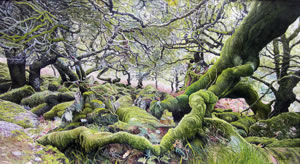Initially I imagined this book to be brimful of lore directly related to the healing properties of plants and trees. Of course, the ‘Folk Tales’ of the title hinted at something darker and more traditional. And Lisa Schneidau herself points out: “Although there is a wealth of plant folklore in these islands, actual folk tales with plants as a main feature are more occasional.”
In a quest to remedy this and to unearth stories that are rooted in the British and Irish landscape, Schneidau has hunted through archives and natural history literature and listened avidly to storytellers, and has left no (mossy) stone unturned. Interestingly, she hails from a traditional wildlife and conservation background. Storytelling, as she puts it, found her. Perhaps that is why her tales, her own versions of traditional ones both known and unknown, are likely to appeal to a broad church, and not just to land-lovers hitherto steeped in the culture of myth and story.
Of course if you’re a fan of folk tales and social media, you’ll probably be keenly aware of the popularity of the Folklore Thursday Twitter feed, embraced by everyone from Robert Macfarlane to wildlife organisations and Nature-themed literary festivals. Avenging or generous-spirited fairies, quietly powerful wise women, murderous, bumbling ogres, ghostly wraiths, Nature goddesses – the stuff of myths and legends has never been more popular, and the full cast of magical beings feature in Botanical Folk Tales. Yet here too are protective, sinister (and even gossipy!) trees, healing, wilful or malevolent plants, wild flowers that enchant humans or summon or dispel fairies, and sensitive, sentient wildlife.
Sometimes flora and fauna combine forces to either help or hinder the human and non-human lives in their midst (and vice versa), for all who dwell in this land’s fields, lowlands, uplands, bogs, moors and towns are interdependent and exist in a delicate balance. Upset the balance, as greedy, plodding humans are wont to do, and let’s just say that The Other in all its forms can be merciless. On the other hand, generosity of spirit, kindness of heart, and a respect for the rhythm and pulse of the natural world are amply rewarded: in her way, the author has crafted a book of folk tales tailor-made for 21st-century environmentalists.
The stories are laid out according to the wheel of the year, starting at the winter solstice. All are prefaced with brief, fascinating nuggets of lore that offer context to the stories themselves. One of my favourites, Mossycoat, features a protective coat made by a gifted woman from “ancient plants and gossamer thread”. We’re told that the druids believed that mosses had the power to prevent misfortune. And so it comes to pass that the enchanted coat not only enables a young woman to escape the clutches of a nefarious suitor, but also leads her to a happily-ever-after ending.
There is real magic being woven here. Schneidau is a talented prose writer, her tales richly but not overly embroidered, and skilfully crafted. A dip into Botanical Folk Tales – best savoured little and often – will surely enrich your relationship with this land and its living heritage.







